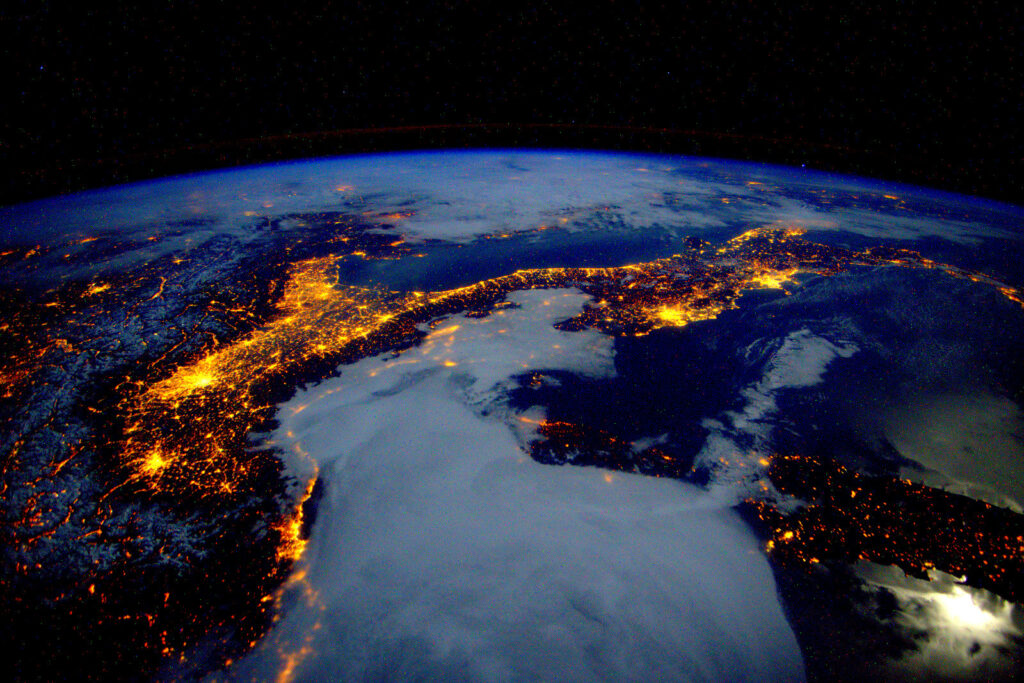Today, environmental concerns literally shape global policies on local and governmental levels. Thanks to Earth observation data obtained from space, we get next-to-real-time insights about climate changes, natural resources, and, most importantly, our technological imprint on the planet’s ‘well-being.’ But even these examples barely scratch the surface of what this Earth observation technology can do. And yet, despite all the benefits of Earth observation satellites (EOS), this tech is not without limitations.
Below, we dig a little deeper into the subject of Earth observation data — what is it, how satellites keep track of our planet, why this technology is important, and what challenges we still need to address to uncover its full potential.
How are Satellites Used for Earth Observation?
Let’s start with the obvious — exactly how Earth observation technology works. The short answer is, that satellites are placed into their destination orbits, where they capture images and send those back to ground stations for analysis. Depending on the data scientists aim to collect, satellites are placed in relevant orbits. For example, Earth observation satellites operating in geostationary orbit capture images from a fixed position around the equator, which ensures continuous coverage of the same area and is ideal for monitoring weather.
However, climate monitoring is usually done with the help of polar-orbiting satellites, travelling in the north-south direction and ensuring global coverage. Constellations of satellites, regardless of orbit placement, work together which ensures frequent and more detailed observations, generally used in disaster monitoring, i.e., wildfires or floods.

So, why is Earth observation data important? Firstly, it provides us with a truly global perspective of both environmental and societal challenges. Besides environmental and disaster monitoring, Earth observation data is used in urban planning, agricultural forecasting, evaluating the impact of technological activities, i.e., mining, and more.
What are the Challenges of Earth Observation Data?
As already mentioned, no tech is without challenges. The first and probably most notable one is the sheer amount of data collected by satellites. Right now, earth observation data analysis requires huge computing resources and advanced algorithms, which is already solved (in part, at least) with the introduction of complex machine learning algorithms.
Another challenge is data accuracy. Earth observation data types, available today, largely depend on imaging technology. For example, optical imagery provides high-resolution images of our planet’s surface, which are further used for mapping and environmental monitoring. Radar imagery, capturing microwave signals to create images, is better suited for monitoring terrain, especially in cloudy conditions. Other types of Earth observation images rely on thermal or hyper-spectral sensors, but the one limitation they all have in common is that space weather may interfere with satellite sensors, causing noise and inaccuracies.
The next proverbial elephant in the room is technology cost and overall accessibility. Earth observation data processing and applications aren’t for everyone, even today when space tech becomes ever more affordable. Developing countries, for example, have very limited access to Earth observation data, and some communities have no access to this EO data whatsoever — even though it pertains to everyone on Earth.
Finally, capturing imagery from space is already starting to raise some legal and ethical concerns as to privacy and data ownership. Today, Earth observation data belongs to whichever party collects it, which may put less informed parties at a disadvantage.
Ways to Address EO Data Challenges
Fortunately, it’s possible to overcome Earth observation challenges. We already mentioned that the introduction of machine learning algorithms helps with data analysis — today’s generative AI is very good at structuring largely unstructured information.

As for strong computing capabilities, services like Google Earth Engine and Amazon Web Services (AWS) offer scalable solutions for storing, processing, and analysing Earth observation data without requiring significant local computational resources.
Improving on Earth observation data accuracy is also a matter of technology — more specifically, advanced calibration and validation protocols for satellite sensors. This requires budget and brain power, of course, which is why the public space sector is actively engaging private players in search of ever-more affordable technologies.
Fortunately, this collaboration also addresses, if only in part, the challenge of EOS accessibility because both NASA and ESA make Earth observation data available to non-profit researchers, policymakers, as well as organizations worldwide. Higher accuracy of Earth observation data, in turn, means better insights into pressing environmental problems and, potentially, a higher chance of finding adequate solutions.
So, as you can clearly see, there is a solution to every issue, and international space organizations are constantly working on advancing Earth observation data science, despite all challenges. So far, it looks like our best chance is in strengthening the collaboration between government agencies and private companies because this combination is already driving impressive results.
After all, the space industry has never before developed at such an unprecedented pace as it does in this century, and it looks like this progress will keep accelerating. Perhaps this progress may even help us find an answer to legal and ethical concerns associated with collecting Earth observation data.

